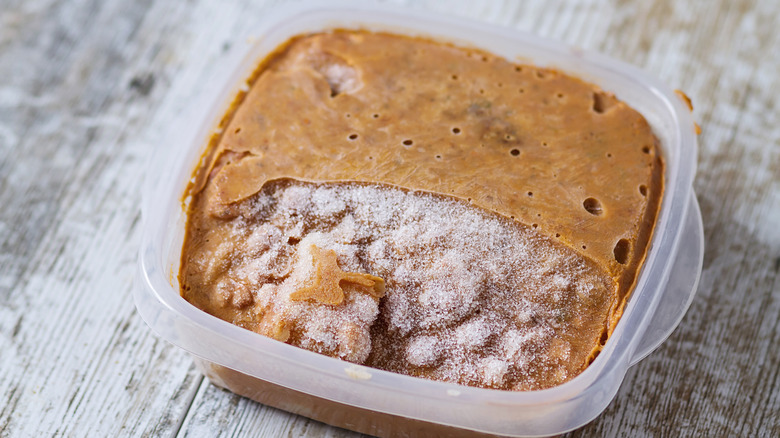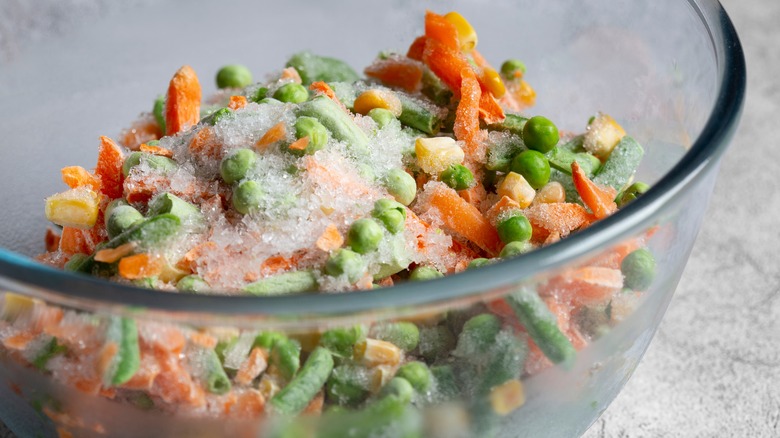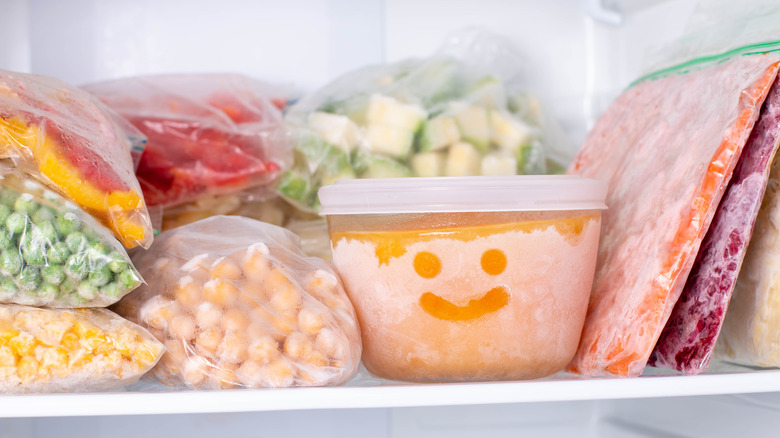The Best Way To Tell If Your Food Is Freezer Burned (And If It's Safe To Eat)
An unfortunate hazard of storing food in a freezer is that it can "burn" in there rather easily. Rather than scorched food that's turned black and ashy because it was left on heat for too long, freezer burn is essentially the result of moisture loss. As food is exposed to the cold and dry air, the water inside it evaporates in a process known as sublimation. These vapors of water solidify, turning into a layer of ice crystals or grainy frost on the surface.
Another thing that happens when food loses moisture is that it comes into contact with air. This exposure to oxygen will alter the flavor of food as well as cause grayish-brown patches of discoloration, so be on the lookout for those too. The loss of water also leads to dehydration, meaning your food may become tough and dry or appear shriveled and leathery.
However, this does not mean that your food is spoiled or expired — just that its quality has deteriorated. Freezer burned food is still perfectly safe to eat, though its flavor, color, and texture may leave much to be desired.
How to salvage your freezer-burnt food
The good news is that there are ways to salvage your food if it's only slightly freezer-burnt. The easiest thing to do is to simply slice off the affected area that looks frosty, tough, or dry — whether it's one end of a bread loaf, the top layer on a tub of ice cream, or even patches of meat.
It also helps to reconsider how you may cook that food. For instance, freezer burn can dehydrate meat and make it leathery, so consider tossing it in a liquid-based recipe to make up for the lost moisture — think broths, stews, and comforting soup recipes. The same goes for fruits and vegetables that wither and shrink in the freezer. Cook them in dishes with plenty of liquids, or blitz them into smoothies and juices where their texture won't make much of a difference.
An important thing to know about freezer burn is that it can subdue the flavor of food and make it taste more bland than usual, so consider being more heavy-handed with the seasoning, too. Smear that bread with herbed butter, turn up the heat on your soups and broths, and add plenty of spices to those smoothies and juices. Even just a squeeze of lemon juice can do wonders to brighten up the flavor of muted, freezer-burned food.
Ways to prevent freezer burn
Although food with light freezer burn can be salvaged, the USDA recommends throwing away anything that appears to be affected severely. This is why it's always best to store your food in a way to avoid this phenomenon in the first place. The most important part here is to use the right packaging so that the food is not exposed to air in any way. Only use airtight freezer-safe bags or glass jars — these are the best types of containers to prevent freezer-burnt food. You'll also want to make sure that any air trapped inside has been squeezed out before you seal the bag or jar. It's even worth using a vacuum sealer to get a truly airtight seal.
Hot food is more susceptible to freezer burn because it emits vapors of steam that can solidify into icicles, so give your casseroles and roasts enough time to fully cool first. Often, the culprit could also be an overloaded freezer. This can have a negative impact on the efficiency of the appliance and slow it down, which in turn increases the likelihood of freezer burn. Temperature fluctuation is another thing that can contribute to that icy frost. Try not to open the freezer door too frequently, and never thaw and refreeze any food more than once — that's one big food storage mistake. These little steps can go a long way in preventing that nasty freezer burn and keep you enjoying your food.



